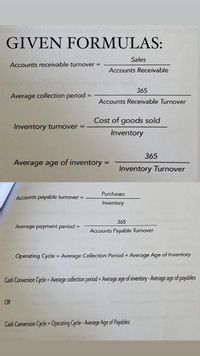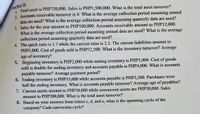
Essentials Of Investments
11th Edition
ISBN: 9781260013924
Author: Bodie, Zvi, Kane, Alex, MARCUS, Alan J.
Publisher: Mcgraw-hill Education,
expand_more
expand_more
format_list_bulleted
Question
NOTE: answer only the last number 8.

Transcribed Image Text:GIVEN FORMULAS:
Sales
Accounts receivable turnover =
Accounts Receivable
365
Average collection period =
Accounts Receivable Turnover
Cost of goods sold
Inventory turnover =
Inventory
365
Average age of inventory =
Inventory Turnover
Purchases
Accounts payable turnover =
Inventory
365
Average payment period =
Accounts Payable Turnover
Operating Cycle = Average Collection Period + Average Age of Inventory
Cash Conversion Cycle = Average collection period + Average age of inventory -Average age of payables
OR
Cash Conversion Cycle = Operating Cycle -Average Age of Payables
%3D

Transcribed Image Text:Practice B.
I Total asset is PHP750,000. Sales is PHPI,500,000. What is the total asset turnover?
2. Accounts receivable turnover is 4. What is the average collection period assuming annual
data are used? What is the average collection period assuming quarterly data are used?
3. Sales for the year amount to PHP100,000. Accounts receivable amount to PHP12,000.
What is the average collection period assuming annual data are used? What is the average
collection period assuming quarterdy data are used?
4. The quick ratio is 1.7 while the current ratio is 2.5. The current liabilities amount to
PHP5,000. Cost of goods sold is PHP52,500. What is the inventory turnover? Average
age of inventory?
5. Beginning inventory is PHP2,000 while ending inventory is PHP5,000. Cost of goods
sold is double the ending inventory and accounts payable is PHP4,000. What is accounts
payable turmover? Average payment period?
6. Ending inventory is PHP13,000 while accounts payable is PHP2,500. Purchases were
half the ending inventory. What is accounts payable turnover? Average age of payables?
7. Current assets amount to PHP30,000 while noncurrent assets are PHP50,000. Sales
amount to PHP200,000. What is the total asset turnover?
8. Based on your answers from letters c, d, and e, what is the operating cycle of the
company? Cash conversion cycle?
Expert Solution
This question has been solved!
Explore an expertly crafted, step-by-step solution for a thorough understanding of key concepts.
This is a popular solution
Trending nowThis is a popular solution!
Step by stepSolved in 4 steps

Knowledge Booster
Learn more about
Need a deep-dive on the concept behind this application? Look no further. Learn more about this topic, finance and related others by exploring similar questions and additional content below.Similar questions
- How many three-letter sequences are possible that use the letters a, p, j, e, z at most once each? ----------------------------------sequencesarrow_forwardarrow_forwardtyping cleararrow_forwardExplain how you divide a decimal number by a power of tenarrow_forwardfor requirement 17, why do you multiply 120 by 11, where does the 11 come from?arrow_forwardsolve it using this method: S2 = (((1+S1)*(1+F2))1/2 )– 1 S3 = ((1+S1)*(1+F3)) 1/3 - 1 P = 50/(1+S1)+50 / (1+S2) 2 + 1050 / (1+S3) 3 and find the value of parrow_forwardarrow_back_iosSEE MORE QUESTIONSarrow_forward_ios
Recommended textbooks for you
 Essentials Of InvestmentsFinanceISBN:9781260013924Author:Bodie, Zvi, Kane, Alex, MARCUS, Alan J.Publisher:Mcgraw-hill Education,
Essentials Of InvestmentsFinanceISBN:9781260013924Author:Bodie, Zvi, Kane, Alex, MARCUS, Alan J.Publisher:Mcgraw-hill Education,

 Foundations Of FinanceFinanceISBN:9780134897264Author:KEOWN, Arthur J., Martin, John D., PETTY, J. WilliamPublisher:Pearson,
Foundations Of FinanceFinanceISBN:9780134897264Author:KEOWN, Arthur J., Martin, John D., PETTY, J. WilliamPublisher:Pearson, Fundamentals of Financial Management (MindTap Cou...FinanceISBN:9781337395250Author:Eugene F. Brigham, Joel F. HoustonPublisher:Cengage Learning
Fundamentals of Financial Management (MindTap Cou...FinanceISBN:9781337395250Author:Eugene F. Brigham, Joel F. HoustonPublisher:Cengage Learning Corporate Finance (The Mcgraw-hill/Irwin Series i...FinanceISBN:9780077861759Author:Stephen A. Ross Franco Modigliani Professor of Financial Economics Professor, Randolph W Westerfield Robert R. Dockson Deans Chair in Bus. Admin., Jeffrey Jaffe, Bradford D Jordan ProfessorPublisher:McGraw-Hill Education
Corporate Finance (The Mcgraw-hill/Irwin Series i...FinanceISBN:9780077861759Author:Stephen A. Ross Franco Modigliani Professor of Financial Economics Professor, Randolph W Westerfield Robert R. Dockson Deans Chair in Bus. Admin., Jeffrey Jaffe, Bradford D Jordan ProfessorPublisher:McGraw-Hill Education

Essentials Of Investments
Finance
ISBN:9781260013924
Author:Bodie, Zvi, Kane, Alex, MARCUS, Alan J.
Publisher:Mcgraw-hill Education,



Foundations Of Finance
Finance
ISBN:9780134897264
Author:KEOWN, Arthur J., Martin, John D., PETTY, J. William
Publisher:Pearson,

Fundamentals of Financial Management (MindTap Cou...
Finance
ISBN:9781337395250
Author:Eugene F. Brigham, Joel F. Houston
Publisher:Cengage Learning

Corporate Finance (The Mcgraw-hill/Irwin Series i...
Finance
ISBN:9780077861759
Author:Stephen A. Ross Franco Modigliani Professor of Financial Economics Professor, Randolph W Westerfield Robert R. Dockson Deans Chair in Bus. Admin., Jeffrey Jaffe, Bradford D Jordan Professor
Publisher:McGraw-Hill Education